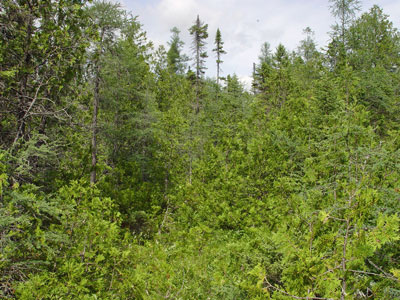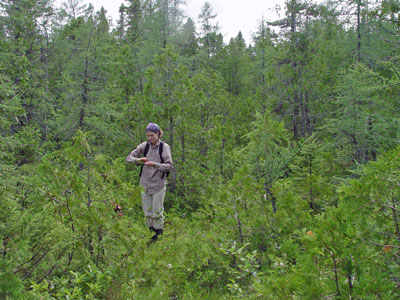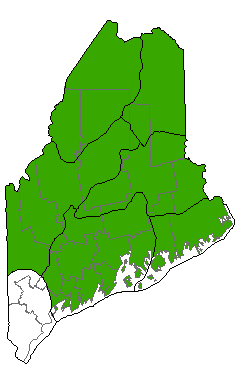DACF Home → Bureaus & Programs → Maine Natural Areas Program → Communities, Plants, and Animals → Natural Community Fact Sheets→ Open Cedar Fen
Printer Friendly Fact Sheet - 1 MB pdf (Get a free copy of Adobe Acrobat Reader)
Open Cedar Fen
Scientific Name: Northern White Cedar Woodland Fen; State Rank: S4

- Community Description
- Soil and Site Characteristics
- Diagnostics
- Similar Types
- Conservation, Wildlife and Management Considerations
- Distribution
- Characteristic Plants
- Associated Rare Plants
- Associated Rare Animals
- Examples on Conservation Lands You Can Visit
Community Description: These open canopy woodlands occur in a peatland setting with northern white cedar dominant. Canopy closure is 20-60%. Black spruce, red maple, balsam fir, black ash, or larch may be mixed with the cedar. The shrub layer may be locally dense with patches of trees and scattered shrubs of winterberry, alder, or mountain holly. The herb layer, usually with >50% cover, is variable in composition and may be predominantly heath shrubs or herbs with a prominent component of graminoids. Shrubby cinquefoil, alpine cotton-grass, sticky false-asphodel, and grass-of-parnassus may be at higher pH sites. The bryoid layer is mostly peat mosses, but the presence of mountain fern moss is indicative of this type. Back to top.
Soil and Site Characteristics: Sites generally occur as part of a peatland (peat >30 cm deep) or occasionally along a peatland outlet stream where the peat substrate is shallower. Sites are in lowlands at elevations up to 1000’, ranging from quite acidic to circumneutral (pH 4.6-7.2), and typical of somewhat minerotrophic (fen) conditions, not raised bog conditions. Back to top.

Diagnostics: Northern white cedar forms a partial canopy (<65%) and is frequently dominant in the shrub layer. Dwarf shrub peatland indicator plants are present. Sites often occur adjacent to an open peatland. Back to top.
Similar Types: Northern White Cedar Swamps and Evergreen Seepage Forests occur on mineral soils or on thin to moderate peat over mineral soil, and not as part of a peatland with forested and non-forested areas (Northern White Cedar Swamps may occasionally occur in that setting). Cedar swamps and seepage forests also have very low cover of peatland dwarf shrubs. Red Maple Fens can be similar, but have far less northern white cedar in the canopy. Gradations from cedar fens to Black Spruce Bogs also occur. Back to top.
Conservation, Wildlife and Management Considerations: These fens usually occur as part of larger peatlands, and maintaining the hydrologic integrity of the entire wetland is key. The cedars generally remain small, therefore this type is typically not a target for forest management. In some areas these fens have been altered by beaver activity.
Conifer-preferring birds that may use this partly open type include black-backed woodpecker, palm warbler, common yellowthroat, Lincoln's sparrow, and Swainson's thrush. Cedar fens that have a large number of dead trees provide habitat for the three-toed woodpecker. Back to top.
Distribution: New England - Adirondack Province and Laurentian Mixed Forest Province, extending eastward, westward, and northward from Maine. Landscape Pattern: Large Patch. Back to top.


Characteristic Plants: These plants are frequently found in this community type. Those with an asterisk are often diagnostic of this community.
- Canopy
- Black spruce*
- Larch*
- Northern white cedar*
- Sapling/shrub
- Balsam fir*
- Black ash*
- Northern white cedar*
- Red maple*
- Speckled alder
- Dwarf Shrub
- Black huckleberry*
- Labrador tea
- Leatherleaf*
- Sheep laurel
- Sweet gale*
- Herb
- Bluejoint*
- Cinnamon fern*
- Creeping snowberry*
- Dwarf raspberry*
- Northern white cedar*
- Three-leaved false Solomon's seal
- Tussock sedge*
- Bryoid
- Dicranum moss*
- Mountain fern moss
- Sphagnum mosses*
- Bog bedstraw
- Dioecious sedge
- Horned beak-rush
- Livid sedge
- Marsh valerian
- Showy lady's-slipper
- Sparse-flowered sedge
- Swamp birch
There are no documented rare animals associated with this natural community.
Examples on Conservation Lands You Can Visit
| Example | County |
|---|---|
| Lake Umbagog National Wildlife Refuge | Oxford Co. |
| Mattagodus Wildlife Management Area | Penobscot Co. |
| Number Five Bog Public Lands | Somerset Co. |